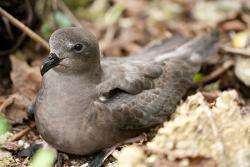Seabird campaign highlights value of species identification

(PhysOrg.com) -- The identification and classification of species (taxonomy) and its value as a scientific discipline has been brought into focus with the continuing fight to save an endangered seabird from extinction, says a University of Derby biologist.
Dr. Graham Rowe was part of the academic research team that discovered the rare Henderson Petrel Pterodroma atrata several years ago on Henderson Island in the South Pacific.
The Henderson Petrel is in the national news this week with the RSPB announcing a partnership with the Pitcairn Islands government to save the Henderson Petrel from the threat of extinction by eradicating the introduced rats which are devastating its chicks and eggs on Henderson Island.
Dr. Rowe, a Senior Lecturer, and Programme Leader for Biology at the University of Derby, was part of a team led by Dr. Michael Brooke from the University of Cambridge, who used plumage colouration, body measurements, mating behavior, vocalization (seabird calls), egg size and DNA sequences to help identify the endangered seabird.
The initially unrecognized Henderson Petrel had previously been considered to be the same species as the more widespread Herald Petrel Pterodroma heraldica which also inhabits islands of the Pitcairn group. A comprehensive taxonomic review of the island's petrels conducted by Dr. Brooke's academic research team concluded the Henderson Petrel was a distinct species.
Dr. Rowe argues the RSPB and the UK Government would never have committed funds to the planned rat eradication process unless the taxonomic work identifying it as a distinct species had first been carried out.
Dr. Rowe said: "Molecular genetic techniques, such as DNA sequencing, have completely refreshed taxonomy which went through a period of being considered a rather dry subject.
"The case of the Henderson Petrel is an excellent example of modern taxonomic approaches being applied to definitively identify, and ultimately protect, an endangered species."
"I am happy and proud that research I have done looks as if it will have a positive outcome for conservation of this species and others on Henderson Island."
Dr. Rowe teaches taxonomy as part of the Biology degree at Derby and has engaged final year student William Avard in an exciting dissertation which takes an applied approach. Dr. Rowe asked him to analyse the distributions of all 30 petrel species from the same group as the Henderson Petrel, to identify candidate Pterodroma species which may currently be in a situation similar to the previously unrecognized Henderson Petrel.
His research suggests there could be a handful of cases where further taxonomic work could have significant conservation implications. Dr. Rowe will take this work forward and seek to publish these findings as a case study.
The Henderson Petrel breeds on the tiny uninhabited Henderson Island - one of the Pitcairn Islands in the South Pacific Ocean. The island is 37 square km in size, and is a UK overseas territory and a World Heritage Site.
The RSPB needs to raise £1.7m for its campaign and is still fundraising to safeguard Henderson Petrel eggs and chicks. The campaign has the backing of Sir David Attenborough.
The Henderson Petrel is listed as endangered on the IUCN (International Union for Conservation of Nature) Red List where the World Conservation Union lists species most at risk of global extinction.
It also features on the Convention of Migratory Species of Wild Animals. Set up as part of the United Nations Environment Program, the Convention, also known as the Bonn Convention, is concerned with the conservation of wildlife and habitats on a global scale.
The RSPB hope to carry out the rat eradication programme in August 2011 - saving thousands of petrel chicks in the process.
RSPB Henderson Island Project Co-ordinator Jonathan Hall added: "The conservation benefits would be enormous. The Henderson Petrel would be saved from its slide towards extinction, a globally significant island restored and at least ten unique species safeguarded for future generations."
Provided by University of Derby















